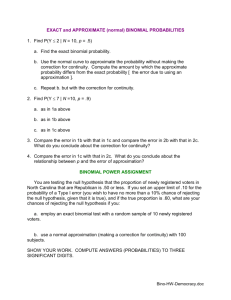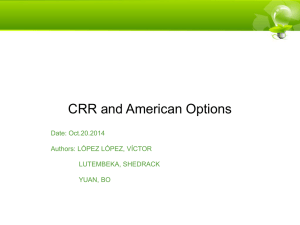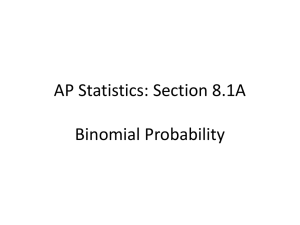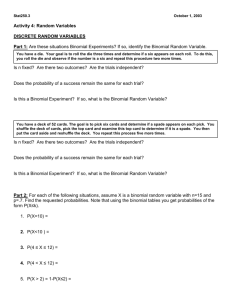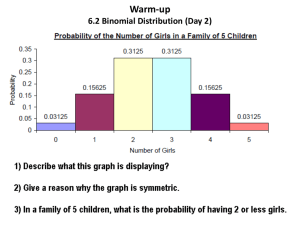The Binomial Model
advertisement
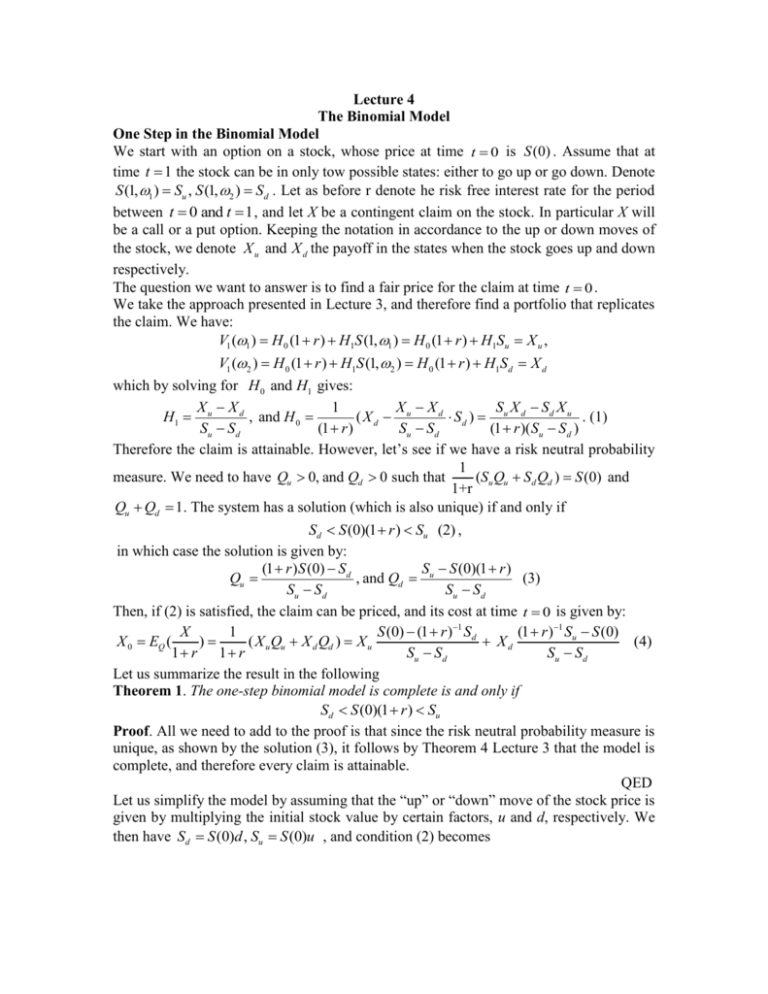
Lecture 4
The Binomial Model
One Step in the Binomial Model
We start with an option on a stock, whose price at time t 0 is S (0) . Assume that at
time t 1 the stock can be in only tow possible states: either to go up or go down. Denote
S (1, 1 ) Su , S (1, 2 ) Sd . Let as before r denote he risk free interest rate for the period
between t 0 and t 1 , and let X be a contingent claim on the stock. In particular X will
be a call or a put option. Keeping the notation in accordance to the up or down moves of
the stock, we denote X u and X d the payoff in the states when the stock goes up and down
respectively.
The question we want to answer is to find a fair price for the claim at time t 0 .
We take the approach presented in Lecture 3, and therefore find a portfolio that replicates
the claim. We have:
V1 (1 ) H 0 (1 r ) H1S (1, 1 ) H 0 (1 r ) H1Su X u ,
V1 (2 ) H 0 (1 r ) H1S (1, 2 ) H 0 (1 r ) H1S d X d
which by solving for H 0 and H1 gives:
X Xd
X Xd
S X Sd X u
1
H1 u
, and H 0
(Xd u
Sd ) u d
. (1)
Su S d
(1 r )
Su S d
(1 r )( Su S d )
Therefore the claim is attainable. However, let’s see if we have a risk neutral probability
1
(Su Qu S d Qd ) S (0) and
measure. We need to have Qu 0, and Qd 0 such that
1+r
Qu Qd 1. The system has a solution (which is also unique) if and only if
Sd S (0)(1 r ) Su (2) ,
in which case the solution is given by:
(1 r ) S (0) S d
S S (0)(1 r )
Qu
, and Qd u
(3)
Su S d
Su S d
Then, if (2) is satisfied, the claim can be priced, and its cost at time t 0 is given by:
S (0) (1 r ) 1 Sd
(1 r ) 1 Su S (0)
X
1
X 0 EQ (
)
( X u Qu X d Qd ) X u
Xd
(4)
1 r 1 r
Su S d
Su S d
Let us summarize the result in the following
Theorem 1. The one-step binomial model is complete is and only if
Sd S (0)(1 r ) Su
Proof. All we need to add to the proof is that since the risk neutral probability measure is
unique, as shown by the solution (3), it follows by Theorem 4 Lecture 3 that the model is
complete, and therefore every claim is attainable.
QED
Let us simplify the model by assuming that the “up” or “down” move of the stock price is
given by multiplying the initial stock value by certain factors, u and d, respectively. We
then have Sd S (0)d , Su S (0)u , and condition (2) becomes
d (1 r ) u (2 '), and (4) becomes
X0
1 1 r d
u 1 r
Xd
Xu
(4 ')
1 r
ud
ud
Example 1. Let us consider S (0) 30, u 1.1, d 0.9, r 1/ 20 and a call option on the
stock with strike price K 31 . We have X max(S (1, ) K ,0), so X u 2 and X d 0.
1
60
3
1
20 3
10
, and Qu , Qd . We find X 0
2
Then t 0 H1 , H 0
which
3
7
4
4
21 4
7
is the same as the value of the portfolio at time t 0 .
The next goal is to generalize this model to more than one step. We will keep the same
notation for the risk free interest rate, but it has to be understood as the rate
corresponding to each step in the procedure. We will also assume that the time elapsed
between two consecutive steps is the same. The final goal will be to consider the behavior
of a stock over a time interval, say [0, T ] , break that interval into smaller time steps, of
length T / n , for some positive integer, n. Then of course, we may let n approach
infinity, and hope that we get a fairly good model for pricing a contingent claim.
Therefore, it makes sense to look at how to price the claim if we consider two steps in the
binomial model. We will assume that from each of the states in the first step, the price of
the stock can go either up by a factor of u, or down by a factor of d. We then obtain three
states and their corresponding prices:
Suu S (0)u 2 , Sud S du S (0)ud , and S dd S (0)d 2 .
We consider as before a contingent claim whose values are denoted X uu , X ud , and X dd .
Let us introduce some notation that could be easily used when we generalize the model.
Notice that at time t 2 the model has three states corresponding to the moves “up, up”,
“up, down” (which is the same as “down, up”), and “down, down”. Let us use a
simplified notation for the stock price: S (2, j ) : j 1, 2,3. Notice that if the stock price
was in state “up” at the first step, it can only get into states 1 or 2 at the second step, and
similarly, from state “down” in first step, can only go to states 2 or 3. We will use the
notation for the contingent claim accordingly.
Now, given the state of the stock price at time t 1, is behavior is identical to the first
step in the binomial model, that was presented at the beginning of this section. We know
that there exists a unique risk neural probability measure, and we can compute the cost of
the contingent claim in the state “up” using (4)
1
X (1, up)
X (2,1) Qu X (2, 2) Qd
1 r
1
1 r d
u 1 r
X (2, 2)
X (2,1)
, and
1 r
ud
ud
1
X (1, 2) : X (1, down)
X (2, 2) Qu X (2,3) Qd
1 r
1
1 r d
u 1 r
X (2,3)
X (2, 2)
.
1 r
ud
ud
Notice that the risk neutral probability measure used in the second step of the model turns
out to be the same as the one used in the first step. There is even more to it: this measure
has to be interpreted as a conditional measure given the state after the first step of the
model. Now we use the values found for the contingent claim at time t 1 to evaluate the
value at time t 0 . We get:
1
X0
( X (1,1) Qu X (1, 2) Qd )
1 r
1
{ X (2,1) Qu2 2 X (2, 2) Qu Qd X (2,3)Qd2 }
(5)
2
(1 r )
1
1 r d
1 r d u 1 r
u 1 r
{ X (2,1)
2 X (2, 2)
X (2, 3)
}.
2
(1 r )
ud
u d u d
ud
2
2
As it becomes apparent from (5), the initial cost of the contingent claim is a discounted
expected value with respect to a risk neutral probability measure, whose values are given
by
1 r d
1 r d u 1 r
u 1 r
2
Q(1) Q
, Q(2) 2Qu Qd
, Q(3) Qd
.
ud
u d u d
ud
A note regarding the risk-free interest rate so that you can relate to the way you will see
the Binomial Model treated in Beck’s text, or other references.
So far we considered the risk-free interest rate for the given step in the model. However,
in many applications the interest rate will be given as an annual rate with continuous
compounding. This means that you will be given r , and then to figure out the discounting
2
2
u
2
factor that replaces (1 r ) you will have to consider e r t , where t is the time elapsed
between two consecutive steps as a fraction of a year. For example, if the duration is one
1
month, then t .
12
This being said, here are some problems for you:
EXERCISES
1. A stock price is currently $100. Over each of the next two six-month periods it is
expected that the stock will either go up by 10% or down by 10%. The risk-free
interest rate is 8% per year, with continuous compounding. What is the value of a
one-year European call with a strike price of $100? Use the binomial model, and
compute the values of the payoff at all the nodes in the tree.
2. Same data as above, compute the value of a one-year European put with strike price
$100? Use the binomial model, and compute the values of the payoff at all the nodes
in the tree. Verify the put-call parity equation.
3. A stock price is currently $30. Each month for the next two months it is expected that
the stock will increase by 8% or reduce by 10%. (Notice that the stock does not
increase or decrease by the same factor!) The risk-free interest rate is 5%. Use a twostep binomial tree to calculate the cost of a derivative that pays off max((30 ST ) 2 , 0)
where ST is the stock price in two months.
Well, these should keep you busy over the weekend.
Enjoy!


